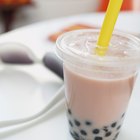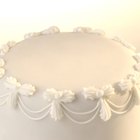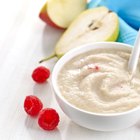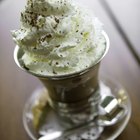
In the world of often-fussy upscale desserts, creme brulee has the elegant simplicity of a classical sculpture or gifted designer's little black dress. It's the king of custards, a rich but uncomplicated combination of cream and egg yolks perfumed with good-quality vanilla. The dessert's deceptively light texture depends on slow, low-temperature cooking, and the finished custard must be chilled before it's served. Preparing it up to a few days in advance is a convenient time saver.
Some Creme Brulee Basics
Although it's best known by its French name, creme brulee -- literally, burnt cream -- is an English dessert. It's thickened primarily with egg yolks, making it soft and rich. It's far too delicate to be unmolded, so creme brulee is served in the same ramekins it's baked in. The signature element that gives the dessert its name is a thin layer of sugar sprinkled on the surface and then caramelized at a high temperature. The dessert can be made ahead of time, but the sugar must be caramelized just before it's served.
The Basic Method
Most creme brulee recipes follow a standard pattern. The vanilla bean is split and scraped, and then the seeds and pod are simmered in hot cream to infuse it with flavor. The egg yolks must be separated and then whisked into the sugar. The hot vanilla-scented cream is stirred into the eggs slowly, raising their temperature gently without causing curdled lumps of cooked egg. Finally, the mixture is strained and measured into individual ramekins. The ramekins of custard are baked in a water bath until just set, removed from the water and then cooled.
Storage
Warm, sweetened cream and eggs represent a perfect breeding ground for bacteria, so making creme brulee ahead of time requires scrupulous attention to food safety. Cool the ramekins on a rack for 30 to 45 minutes until they're barely warm to the touch, and then cover and refrigerate them. The custards can be stored for up to 5 days without loss of quality, though to maximize food safety the U.S. Department of Agriculture recommends refrigerating them for no longer than 3 or perhaps 4 days. To stack the deck further in favor of food safety, use pasteurized eggs or egg yolks to make the creme brulee.
Finishing the Desserts
When it's time to serve the desserts, take them out of the refrigerator and uncover them. A small amount of condensation on the surface of the custard is normal, especially in humid climates. Just blot it up carefully with a clean paper towel until the custard's surface is dry. Sprinkle a small amount of sugar over each custard, and turn the ramekin to ensure it spreads evenly. Pass the flame of a propane or butane torch lightly over the sugar, melting and then caramelizing the sugar. The sugar shell should be light and thin enough to crack easily with a spoon. If you use too much sugar, the caramelized layer will be hard and impenetrable.
Related Articles

Can Panna Cotta Be Made in a Large Dish?

Custard vs. Pastry Cream

How to Make Creme Brulee Without a Torch

Can You Toast Marshmallow Creme?

Do Boston Cream Pie Cupcakes Need ...

Can You Reheat Tapioca?

What Is a Souffle Dish?

What Is the Difference Between Creme ...
A Substitute for Meringue

Do You Let Cooked Chocolate Icing Cool ...

How to Stiffen Meringue

How to Keep Custard Sauce From Curdling

List of French Pastries

How to Make a White Decorator Icing

How to Melt White Sugar for Flan

How to Make Simple Glazed Walnuts

How to Make Liquid Sugar Concentrate

How Many Calories Are in Cream of Wheat?

How to Make Whipped Frosting Without ...

Adding Vanilla Pudding to Whipping Cream
References
- The Professional Pastry Chef; Bo Friberg
- U.S. Department of Agriculture Food Safety and Inspection Service: Shell Eggs From Farm to Table
Writer Bio
Fred Decker is a trained chef and prolific freelance writer. In previous careers, he sold insurance and mutual funds, and was a longtime retailer. He was educated at Memorial University of Newfoundland and the Northern Alberta Institute of Technology. His articles have appeared on numerous home and garden sites including GoneOutdoors, TheNest and eHow.
Photo Credits
Jupiterimages/Photos.com/Getty Images